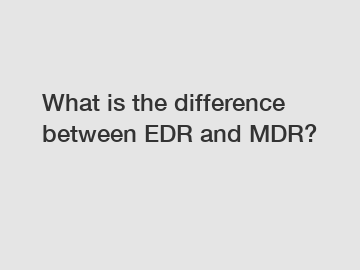What is the difference between EDR and MDR?
In today's digital landscape, where cyber threats loom large, organizations must take proactive measures to safeguard their sensitive data and systems. Two widely adopted cybersecurity approaches are Endpoint Detection and Response (EDR) and Managed Detection and Response (MDR). While the acronyms might appear similar, understanding the differences between EDR and MDR is essential for implementing the most effective cybersecurity strategy. In this article, we will delve into the characteristics and distinctions of both EDR and MDR, helping you make informed decisions to strengthen your defenses against cyber threats.
Endpoint Detection and Response (EDR):
EDR primarily focuses on monitoring and analyzing endpoint activities within an organization's network. Endpoints refer to devices like laptops, desktops, servers, and mobile devices that connect to a network. EDR solutions are designed to gather data from endpoints, offering real-time visibility into potential threats and suspicious activities. By utilizing advanced techniques like behavioral analytics and machine learning algorithms, EDR solutions rapidly detect and respond to security incidents.

EDR Benefits:
1. Rapid threat detection: EDR provides a comprehensive view of endpoint activity, allowing security teams to quickly identify potential threats and malicious behavior.
2. Real-time response: EDR solutions offer automated response capabilities, enabling swift containment and remediation of security incidents.
3. Enhanced visibility: Monitoring endpoints provides organizations with valuable insights into their network's security posture, aiding in overall risk management.
4. Protection against zero-day attacks: EDR's advanced analytical techniques help identify and mitigate previously unknown vulnerabilities, protecting against zero-day attacks.
Managed Detection and Response (MDR):
While EDR focuses primarily on endpoint security, MDR takes a more holistic approach. MDR services typically involve outsourcing the monitoring, detection, and response functions to a dedicated third-party service provider. MDR solutions leverage cutting-edge technologies and expert security analysts to detect, investigate, and mitigate cyber threats throughout an organization's entire network infrastructure.
MDR Advantages:
1. Expert analysis and guidance: MDR services provide organizations with access to cybersecurity professionals who possess deep knowledge and experience in threat detection and response.
2. 24/7 monitoring: MDR providers ensure continuous monitoring of network activities, enabling timely identification and response to security incidents outside regular business hours.
3. Integrated threat intelligence: MDR leverages threat intelligence feeds to identify emerging threats and proactively adapt security measures to counteract them.
4. Reduced burden on internal resources: By outsourcing threat detection and response, organizations can focus on their core competencies, leaving the complex task of cybersecurity to dedicated professionals.
Key Differences Between EDR and MDR:
1. Scope: EDR primarily monitors endpoints, while MDR provides a more comprehensive view, monitoring an entire network's infrastructure and activities.
2. Ownership: EDR solutions are typically implemented and managed internally, while MDR involves outsourcing to third-party service providers.
3. Skillset: EDR tools rely heavily on automation and machine learning algorithms, whereas MDR incorporates human expertise to analyze and respond to threats effectively.
4. Continuous monitoring: MDR services offer round-the-clock monitoring, enabling timely incident response even during non-business hours.
Choosing the Right Approach:
Finding the right cybersecurity approach depends on various factors such as organizational size, budget, security objectives, and available resources. Smaller organizations with limited resources may opt for EDR solutions due to their ease of deployment and affordability. On the other hand, larger enterprises with complex networks and higher security requirements may choose MDR for its comprehensive coverage, round-the-clock monitoring, and access to expert guidance.
Conclusion:
In an era of persistent cyber threats, organizations must deploy robust cybersecurity measures to keep sensitive data and systems safe. While EDR and MDR share the common goal of protecting against cyber threats, they differ in scope, implementation, and expertise. Understanding these differences enables organizations to select the most suitable approach to bolster their cybersecurity posture. Implementing either EDR or MDR, or a combination of both, organizations can enhance their overall security strategy and minimize the risk of falling prey to cyberattacks.
Are you interested in learning more about custom snowboard helmet, Shock-Resistant Packaging Solutions, custom football shin guards? Contact us today to secure an expert consultation!


